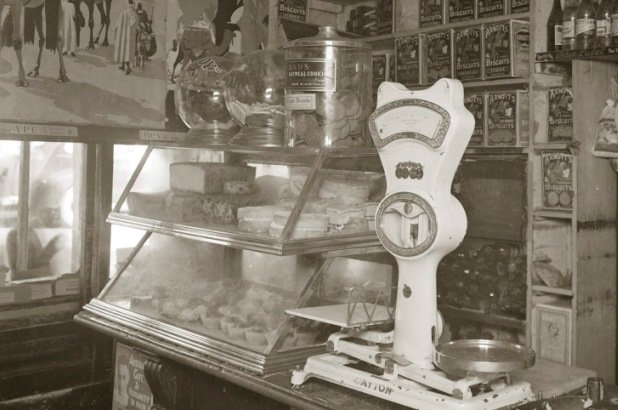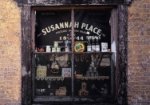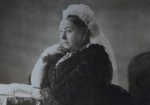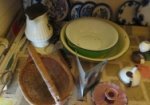So far we’ve told our culinary stories through kitchens, kitchenalia, cookbooks and manuscripts; I think this is the first time we’ve looked at a police forensic photograph!
Housed at the Justice & Police Museum the NSW forensic archive shot (pun intended) to prominence with the City of Shadows exhibition and accompanying book in 2005-6. Since then the book has been reprinted 3 times, and the photographs have inspired fashion designers and bloggers. For us however there is the incredible detail the photographs preserve about the setting for everyday, unedited life.
There are surreal, empty street scenes where a single face peeps around a telegraph pole; upturned motor cars surrounded by fascinated onlookers; everyday interiors of homes, shops and businesses. Ultimately these are crime scene photographs, and there are many that are, well, lets just say they’re ‘graphic’ in nature.
I was chatting with Justice & Police Museum curator Nerida Campbell today about just one photograph in particular, an anonymous grocery shop interior from the 1930s. What took place here isn’t known: was it a hold-up? Was something illicit being sold ‘under the counter’? We may never know.
What got us talking though is the sheer amount of detail that’s packed into this one view. And this is the important bit: these photographs aren’t styled, created views. They’re actual scenes that, especially where this blog is interested, are packed with information about food, dining and shopping. A table setting or a pot on a stove is just as it was left; a coat over a dining chair is where it was placed by its owner, a shop display is exactly as it was arranged by the shopkeeper. They provide an incredible, visually dense record of everyday life – be it innocent or intensely sordid.
At the corner shop
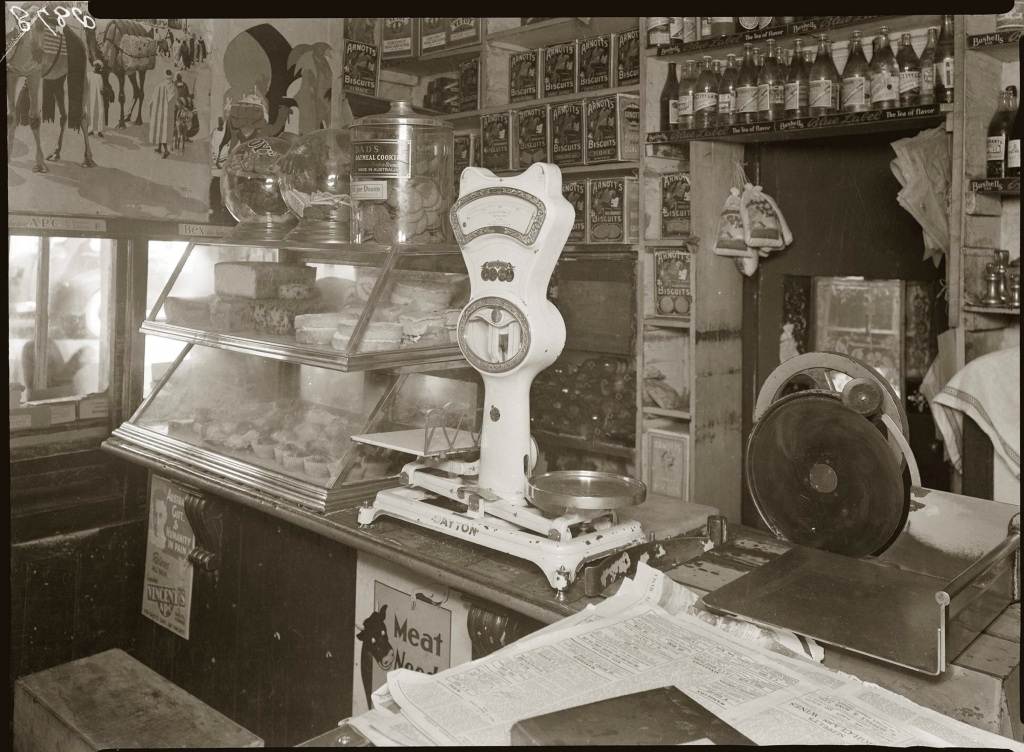
Unknown 1930s grocery shop scene. NSW Police Forensic Photography Archive, Justice and Police Museum, Sydney Living Museums
This everyday ‘corner store’ was photographed after an unknown incident sometime in the 1930s, before the time when the corner shop as an entity would face a new competitor: the rise of the supermarket. It was still, as Nerida points out, service from behind the counter, not self-service in the shop aisle.
It’s a humble scene: sheets of newspaper for are on the worn counter – note the ornamental brackets under the top – ready for wrapping a purchase, bottles of Shelley’s soft drinks and ginger beer above the central door to a back room and what may be a stack of bottles brought back to be refilled; a circular-bladed bread slicer; shop scales, with the weights resting on the shelf behind like shiny chess pieces.
A Bex and a good lie down
In many shop scenes like this you can see ads for the iconic Bex and Vincent’s APC powders. Stuck to the counter front is an ad for the latter – enthusiastically announcing “Australia’s Gift to Humanity in Pain!” The catch-phrase ‘A Bex and a good lie down’ long ago entered the Australian lexicon: it wasn’t until many decades later that the highly addictive and dangerous nature of ‘the housewife’s friend’ became known.
Half a pound of biscuits please
Detail of crime scene photograph showing biscuit tins. NSW Police Forensic Photography Archive, Justice and Police Museum, Sydney Living Museums
This shop presumably did quite a trade in biscuits, going by how many bulk tins are stacked on the shelves. Home, Ve Toy and (on the top shelf) Coconut Macaroons can be made out. To the left a jar of ‘Dad’s oatmeal cookies – the better British biscuit! – Made in Australia! Four-pence a dozen!‘ sits on the crowded counter top.
…and a cake anyone?
Detail of crime scene photograph showing cakes in a display case. NSW Police Forensic Photography Archive, Justice and Police Museum, Sydney Living Museums
Two glass display cases sit stacked to one side, housing a somewhat, well, lets call it a ‘casual arrangement’ of sponge cakes, jam rolls, cupcakes and sultana-laden fruit cakes. The 2-layer sponge cakes with their jam and cream fillings are jammed in at all odd angles, whole or cut into smaller pieces wrapped in paper. A convenient upturned packing case on the floor was no doubt placed to give children the chance to peer into the case – and badger their mother to buy them a sweet treat.
You can’t help but get the feeling though that with their less than attentive attitude to visual merchandising (did you notice the crumbs under the scales?) maybe, just maybe, cakes and lemonade isn’t really what this store was most intent on selling… And that’s the point with these photographs. They’re so evocative that you can’t help but create a story to go with the image, writing your own Raymond Chandler scene.
Chicory anyone?
Detail of posters in a shop scene. NSW Police Forensic Photography Archive, Justice and Police Museum, Sydney Living Museums
There’s one detail that really had us intrigued: at top left is a montage of poster parts showing an exotic Arabic scene: there are men in North African clothing (are they Egyptian? Moroccan?), heavily laden camels and donkeys, a pointed horse-shoe archway. Could this be from advertising for cigarettes? Coffee or chicory? Is it a tourism poster for Morocco or Algeria? Had someone seen the 1930 film Morocco with Cary Grant and Marlene Dietrich, and was trying to bring a bit of the Hollywood glamour into their shop?
Both of us feel like we’ve seen the image before, so if it rings a bell with you please let us know.
Second helpings
You can read more about Nerida Campbell’s ‘life in crime’ here.
At the Justice & Police Museum you can step into the dark side of Sydney’s past with a visit to the Water Police station and courts that once made up one of the city’s busiest legal hubs. Crooks and cops, thugs and judges, locals and drifters, the guilty and the innocent have all left their stories here. With its 1890s holding cells, offices, charge room and courts, the museum draws you into a world of crime, punishment and policing, from bushrangers, sly grog and razor gangs to forensics. A vast archive of crime scene photography and mug shots reveal more than a century of underworld Sydney.
